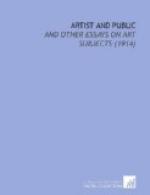No, it is not for the sake of unhampered personal development that young artists are joining these new schools; it is because they are offered a short cut to a kind of success. As there are no more laws and no more standards, there is nothing to learn. The merest student is at once set upon a level with the most experienced of his instructors, and boys and girls in their teens are hailed as masters. Art is at last made easy, and there are no longer any pupils, for all have become teachers. To borrow Doctor Johnson’s phrase, “many men, many women, and many children” could produce art after this fashion; and they do.
So right are the practitioners of this puerile art in their proclaimed belief that the public will never accept it while anything else exists, that one might be willing to treat it with the silent contempt it deserves were it not for the efforts of certain critics and writers for the press to convince us that it ought to be accepted. Some of these men seem to be intimidated by the blunders of the past. Knowing that contemporary criticism has damned almost every true artist of the nineteenth century, they are determined not to be caught napping; and they join in shouts of applause as each new harlequin steps upon the stage. They forget that it is as dangerous to praise ignorantly as to blame unjustly, and that the railer at genius, though he may seem more malevolent, will scarce appear so ridiculous to posterity as the dupe of the mountebank. Others of them are, no doubt, honest victims of that illusion of progress to which we are all more or less subject—to that ingrained belief that all evolution is upward and that the latest thing must necessarily be the best. They forget that the same process which has relieved man of his tail has deprived the snake of his legs and the kiwi of his wings. They forget that art has never been and cannot be continuously progressive; that it is only the sciences connected with art that are capable of progress; and that the “Henriade” is not a greater poem than the “Divine Comedy” because Voltaire has learned the falsity of the Ptolemaic astronomy. Finally, these writers, like other people, desire to seem knowing and clever; and if you appear to admire vastly what no one else understands you pass for a clever man.
I have looked through a good deal of the writings of these “up-to-date” critics in the effort to find something like an intelligible argument or a definite statement of belief. I have found nothing but the continually repeated assumption that these new movements, in all their varieties, are “living” and “vital.” I can find no grounds stated for this assumption and can suppose only that what is changing with great rapidity is conceived to be alive; yet I know nothing more productive of rapid changes than putrefaction.




